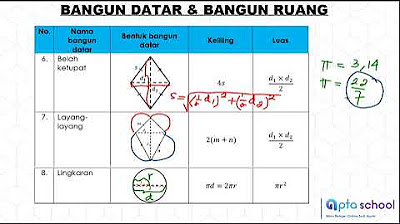Similar Shapes: Length, Area and Volume
Summary
TLDRThis educational script discusses the concept of similar shapes, using cubes and prisms as examples. It explains that similar shapes have proportional dimensions, with the scale factor of lengths multiplied by the same factor. The script elaborates on how this scale factor affects areas and volumes differently: area scales with the square of the length factor, while volume scales with its cube. Practical examples are given to demonstrate calculating the volume of prisms based on their scale factors, emphasizing the mathematical patterns behind geometric similarities.
Takeaways
- 🔍 Two shapes are similar if they have undergone uniform enlargement by the same scale factor.
- 📐 Cubes are always similar shapes because their dimensions are proportionally scaled.
- 📏 The length scale factor is the ratio of corresponding linear dimensions of similar shapes.
- 📈 The area scale factor is the square of the length scale factor.
- 📊 The volume scale factor is the cube of the length scale factor.
- 🧩 For cubes, scaling one dimension differently would result in a shape that is no longer a cube.
- 🔢 The volume of a cube is calculated by multiplying its length, width, and height.
- 📋 To find the volume of a larger similar prism, multiply the volume of the smaller prism by the cube of the length scale factor.
- 🔄 The ratio of surface areas between similar prisms can be used to find the ratio of their volumes by considering the scale factors.
- 📘 When given the volume ratio of similar shapes, you can find the scale factor by dividing the larger volume by the smaller one and then taking the cube root to find the linear scale factor.
- 📌 The surface area of similar shapes scales with the square of the linear dimensions, not the volume.
Q & A
What is the definition of similar shapes?
-Two shapes are similar if there has been a uniform enlargement, meaning all lengths of a shape have been multiplied by the same scale factor.
Why are all cubes always similar shapes?
-All cubes are similar shapes because if you scale their dimensions by the same factor, the proportions remain constant.
How do you calculate the area scale factor when comparing similar shapes?
-The area scale factor is calculated by squaring the length scale factor.
What is the volume scale factor for a shape that has been scaled by a factor of 2?
-The volume scale factor is 2 cubed, which equals 8.
If Prism A has a length of 10 cm and Prism B has a length of 20 cm, what is the scale factor for length?
-The scale factor for length is 2, as you multiply by 2 to get from 10 cm to 20 cm.
How do you find the volume of a larger prism when given the volume of a smaller similar prism?
-You multiply the volume of the smaller prism by the volume scale factor, which is the cube of the length scale factor.
What is the relationship between the surface area ratio and the volume ratio of similar prisms?
-The volume ratio is the cube of the surface area ratio's square root.
If the surface area of two similar prisms is in the ratio of 25 to 4, what is the volume ratio?
-The volume ratio is the cube of the square root of the surface area ratio, which is 125 to 8.
How can you find the volume of a smaller similar cone if you know the volume of a larger one?
-You divide the volume of the larger cone by the cube of the length scale factor to find the volume of the smaller cone.
If two similar cones have volumes in the ratio of 27 to 64, what is the ratio of their surface areas?
-The ratio of their surface areas is the square of the ratio of their lengths, which is 9 to 16.
What is the volume of Cone A if Cone B has a volume of 3200 cm³ and the surface area ratio of Cone A to Cone B is 35 cm² to 560 cm²?
-First, find the scale factor for the surface area (16), then find the length scale factor (4), and finally calculate the volume scale factor (64). Divide the volume of Cone B by the volume scale factor to get the volume of Cone A, which is 50 cm³.
Outlines

هذا القسم متوفر فقط للمشتركين. يرجى الترقية للوصول إلى هذه الميزة.
قم بالترقية الآنMindmap

هذا القسم متوفر فقط للمشتركين. يرجى الترقية للوصول إلى هذه الميزة.
قم بالترقية الآنKeywords

هذا القسم متوفر فقط للمشتركين. يرجى الترقية للوصول إلى هذه الميزة.
قم بالترقية الآنHighlights

هذا القسم متوفر فقط للمشتركين. يرجى الترقية للوصول إلى هذه الميزة.
قم بالترقية الآنTranscripts

هذا القسم متوفر فقط للمشتركين. يرجى الترقية للوصول إلى هذه الميزة.
قم بالترقية الآنتصفح المزيد من مقاطع الفيديو ذات الصلة
5.0 / 5 (0 votes)






